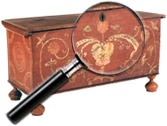|
|
Carleton Eugene Watkins – American Photographer 1829 to 1916
Carleton Watkins is best known for his photographs of the California landscape. He first left his native New York around 1850 to head west at the time of the California Gold Rush. He settled in San Francisco, where he was introduced to photography by daguerreotypist, Robert Vance.
Watkins soon began taking photographs of the California region, in particular Yosemite and the Mariposa Valley. His images [...] Click here to continue reading.
Milton Clark Avery (American, 1885 to 1965)
Milton Avery was one of 20th century America’s foremost artists, known for his unique combination of color and abstraction, and his depiction of the natural world. Born in 1885 in Altmar, New York, Avery was interested in art from an early age. He studied art at the Connecticut League of Art Students in Hartford and the Art Society of Hartford, while working various factory jobs to support [...] Click here to continue reading.
Hiroshi Sugimoto (Japanese/American, born 1948)
Japanese photographer Hiroshi Sugimoto left Japan for Los Angeles in 1970. There he became inspired by the universal facets of Minimalist painting and sculpture which came to dominate his work. His photographs have explored the aesthetic and conceptual boundaries of photography for more than thirty years. Through the use of a large-format camera and extremely long exposures, Sugimoto explores his themes through a rigorous use of continuality. Sugimoto captures [...] Click here to continue reading.
Robert Gould Shaw (1837-1863)
Harvard-educated Robert Shaw, son of a prominent Boston abolitionist family, was serving as a captain in the 2nd Massachusetts when he was tapped by Governor John Andrew to command the first regiment of black troops organized in a Northern state. Shaw went about the organization of his 54th Massachusetts recruiting free blacks from all over New England and some from beyond. The regiment was mustered into service on May 13, [...] Click here to continue reading.
Brassai (French/Hungarian, 1899 to 1984)
Gyula Halasz was born in Hungary in the last year of the 19th century, and only used Brassai as a name for his photographic pursuits years later. After serving in World War I at the tender age of 17, Brassai returned home to study fine art. He also started to work in journalism as a means to support his artistic endeavors. When the French finally lifted their ban on [...] Click here to continue reading.
Sioux Chief Gall (ca 1840-1894)
Hunkpapa Sioux Chief Gall was famous for his military efforts in the wars against the US and for his participation in the Battle of Little Bighorn in 1876.
Information courtesy of Cowan’s Auctions Inc.
Rain-in-the-Face (1835-1905)
Chief Rain-in-the-Face, whose Hunkpapa name was Canku-Ota, built his reputation as a warrior while young. He participated in both the Fetterman Massacre and the Battle of the Little Big Horn. Reputedly he killed Tom Custer and cut out his heart on the battlefield — a story he vehemently denied.
Information courtesy of Cowan’s Auctions Inc.
Chief Spotted Tail (1823-1881)
Spotted Tail, whose Lakota name was Sinte Gleska, served his people as a statesman and went to Washington to lobby for the rights of his people.
Information courtesy of Cowan’s Auctions Inc.
Graflex Speed Graphic Cameras
In many ways, the Speed Graphic was America’s first and last great camera. It was manufactured by Graflex, a Rochester, New York based camera producer. It was the dominant portable professional camera from the 1930′s through the end of the 1950′s. The Speed Graphics and their brethren, the Crown Graphic and Century Graphic are remarkable cameras capable of the highest quality of work. The older Graflex SLR with its patented [...] Click here to continue reading.
Vincent Chevalier (1771-1841)
Vincent Chevalier is an important figure in photographic history, the Parisian optician was instrumental in bringing together Louis Daguerre and Nicephore Niepce in 1829. Both had been working separately to record images chemically. Daguerre – artist, owner and operator of the Paris Diorama – wanted to fix images formed in the camera obscura, while Niepce had been experimenting since 1813 with the mechanical reproduction of images on pewter plates using sulfur, [...] Click here to continue reading.
|
Recent Articles
- Charles Alfred Meurer – American Artist & Tromp L’Oeil Artist
- Sendak, Maurice – American Artist & Writer
- Godie, Lee – American Artist
- Davis, Vestie – American Artist
- Bartlett, Morton – American Artist
- Mackintosh, Dwight – American Artist
- Evans, Minnie Jones – African-American Artist
- Mumma, Ed (Mr. Eddy) – American Artist
- Nice, Don – American Artist
- Savitsky, John (Jack) – American Artist
- Gordon, Harold Theodore (Ted) – American Artist
- Dial, Thornton – African-American Artist
- Doyle Sam – American Artist
- Johnson, Lester Frederick – American Artist
- Finster, Howard – American Artist
|
|
